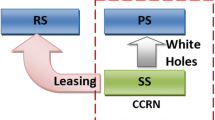Abstract
The technology of DSA (Dynamic Spectrum Access) will be adopted in the next generation of wireless network to maximize spectrum utilization. The fundamental challenge of applying DSA into wireless network is how to provide efficient spectrum allocation and rate control for DSA users. In this paper, we propose a Stable and Efficient Solution, called SES, to optimize the rate control and spectrum allocation in a typical enterprise or campus wireless LAN. SES is decoupled into three independent algorithms for initial spectrum allocation, rate control, and dynamic spectrum allocation. A distributed algorithm adopting the technique of Lyapunov optimization is designed to tune the rate control of client and AP (Access Point). Furthermore, to maximize spectrum utilization, we introduce a novel notion, called “Virtual Queue of Sub-network”, to evaluate the realistic spectrum demand of individual AP radio, based on which a centralized algorithm has been developed to dynamically optimize the spectrum allocation. Theoretical analysis shows that SES can make optimal decision on rate control and spectrum allocation, and stabilize network with explicit performance bounds. Simulation results demonstrate that SES can achieve up to 90% improvement in throughput and 50% reduction in queue length, as compared to the solution of fixed channel.
Similar content being viewed by others
References
FCC 03-322 NPRM on Cognitive Radio, http://hraunfoss.fcc.gov.
McHenry, M. (2003). Spectrum white space measurements. Presentation to New America Foundation BroadBand Forum, June 20, 2003. http://www.newamerica.net.
Chandra, R., Mahajan, R., Moscibroda, T., Raghavendra, R., & Bahl, P. (2008). A case for adapting channel width in wireless networks. In Proceedings of ACM SIGCOMM.
Moscibroda, T., Chandra, R., & Wu, Y. (2008). Load-aware spectrum distribution in wireless LANs. In Proceedings of IEEE, ICNP 2008.
Evans, J., Raychaudhuri, D., & Paul, S. (September 2006). Overview of wireless, mobile and sensor networks in GENI. GENI Design Document 06–14, Wireless Working Group.
Stevenson, C. R., et al. (July 17, 2006). Tutorial on the P802.22.2 PAR for: Recommended Practice for the Installation and Deployment of IEEE 802.22 Systems. IEEE 802, San Diego, CA.
Georgiadis L., Neely M. J., Tassiulas L. (2006) Resource allocation and crosslayer control in wireless networks. Foundations and Trends in Networking 1(1): 1–149
Tassiulas, L., & Ephremides, A. (1992). Stability properties of constrained queueing systems and scheduling policies for maximum throughput in multihop radio networks. IEEE Transactions on Automatic Control, 37(12).
Neely, M. J., Modiano, E., & Li, C. (2005). Fairness and optimal stochastic control for heterogeneous networks. In Proceedings of IEEE INFOCOM.
Sharma, G., Shroff, N. B., & Mazumdar, R. R. (2006). Maximum Weighted Matching with Interference Constraints. PerCom Workshops, pp. 70–74.
Bertsekas D. (1999) Nonlinear Programming (2nd ed.). Athena Scientific, Belmont
Zhao Q., Sadler B. M. (May 2007) A survey of dynamic spectrum access: Signal processing, networking, and regulatory policy. IEEE Signal Processing Magazine 24(3): 79–89
Bahl, P., Chandra, R., Moscibroda, T., et al. (2009). White space networking with Wi-Fi like connectivity. In Proceedings of ACM SIGCOMM.
Yuan, Y., Bahl, P., Chandra, R., Moscibroda, T., & Wu, Y. (2007). Allocating dynamic time-spectrum blocks in cognitive radio networks. In Proceedings of ACM MOBIHOC.
Feng, Z., & Yang, Y. (2009). Joint transport, routing and spectrum sharing optimization for wireless networks with frequency agile radios. In Proceedings of IEEE INFOCOM.
Author information
Authors and Affiliations
Corresponding author
Rights and permissions
About this article
Cite this article
Chen, J., Li, H., Wu, J. et al. SES: Stable and Efficient Solution for Rate Control and Spectrum Allocation in Wireless LANs. Wireless Pers Commun 66, 81–99 (2012). https://doi.org/10.1007/s11277-011-0327-2
Published:
Issue Date:
DOI: https://doi.org/10.1007/s11277-011-0327-2




